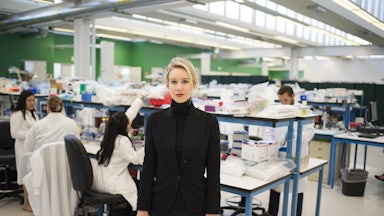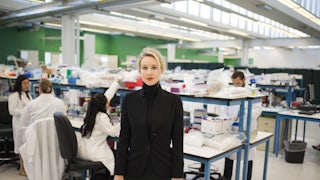As the criminal trial of Elizabeth Holmes—the disgraced former CEO of the defunct blood-testing startup Theranos, who allegedly defrauded investors, physicians, and patients—unfolds in San Jose, California, rubberneckers have no shortage of content over which to obsess. The tale of the blonde Stanford dropout who parlayed a try-hard Steve Jobs impression into a $9 billion valuation for a company whose proprietary technology never actually worked has been elevated to “cultural phenomenon” status since the story first broke in 2015. Anyone wishing to catch up on the lurid details of how Holmes went from being the darling of the business press to the nation’s highest-profile criminal defendant has a bestselling book, a hit podcast series, and an acclaimed HBO documentary to choose from, not to mention an upcoming miniseries and feature film. At least two slickly produced podcasts are now covering the trial, and reporters from multiple media outlets are struggling to score seats in a courtroom whose capacity has been limited by the pandemic.
The public’s fascination with the Elizabeth Holmes saga isn’t particularly tough to understand: It’s a shocking “fake it ’til you make it” story about a firm’s staggering rise and equally dramatic fall, amid Silicon Valley’s bonkers gold rush, with a novel spin: Theranos’s foray into health care imbued the boom and bust with a higher set of stakes than it might have possessed had Holmes just wanted to be a bog-standard app developer. These media narratives correctly observe that the firm’s fraudulent lab results put patients in danger and investors’ noses out of joint. Where they come up short, however, is in properly contextualizing Theranos’s place within the broader health care system. Far from hawking a “too good to be true” innovation, Theranos peddled a toxic vision of consumer-driven medicine that no one ever needed in the first place.
The elevator pitch that cajoled hundreds of millions from investors’ pockets was presumably similar to Holmes’s 2014 Ted Talk, which has since been yanked from the internet. In it, the buzzy wunderkind recounted the story of how her beloved uncle’s untimely death from metastatic cancer and her own paralyzing fear of needles inspired her to dream up a way to screen for some 200 medical conditions early and often, using only a single drop of blood from one finger prick in lieu of multiple vials from a full-on venipuncture. Such an innovation, she reasoned, might have led to her uncle being diagnosed much earlier, which could have lengthened his life considerably. Holmes also emphasized that democratizing health data through ubiquitous screening on demand, without a doctor’s orders, would produce a slew of societal benefits: “Imagine a world in which consumers were empowered to take any blood test, whenever they wanted, allowing them to access crucial information at the moment it really matters.”
Well! I am imagining it, and it sucks. Setting aside a strong hunch that the type of needle phobia Holmes described was feigned for the sake of marketing and isn’t actually particularly widespread, the blood-test-shopping utopia that Holmes dreamed up arguably raises more problems than it solves: As Stanford’s John Ioannidis wrote in the Journal of the American Medical Association, catching diseases through proactive screening in the absence of symptoms doesn’t necessarily do much to improve outcomes.
So the admittedly emotionally stirring idea that Theranos could have saved Elizabeth’s uncle if only he’d gotten a finger prick at Walgreens is probably bunk. Combine that with a significant rate of false positives that inevitably pop up when lab tests aren’t medically indicated, the risks of overtreatment, and the fact that most blood tests don’t actually yield some neat “yes” or “no” result and must be interpreted in context to truly deliver high-quality care to patients, and you’re left scratching your head and wondering what diagnostic problem Theranos was even positioned to solve.
Nonetheless, Theranos pushed hard for its “patients-as-consumers” idyll, lobbying Arizona lawmakers to pass legislation the company practically devised itself to allow individuals to order lab tests without a physician to facilitate the company’s big rollout into several-dozen stores. But the state’s loosey-goosey regulatory climate wasn’t the only reason the firm zeroed in on it as a springboard for its product: Arizona’s high rate of uninsured residents also struck Holmes and her colleagues as a business opportunity, as they imagined that people paying out of pocket could be enticed by Theranos’s low-priced menu and try to make do without access to primary care.
And for anyone rightfully wondering what, exactly, an uninsured person with better access to lab testing would even do about a diagnosis for which they couldn’t afford the treatment, Holmes had a go-to example: Type 2 diabetes, she offered in her Ted Talk, drives some 20 percent of national health care costs and is manageable through lifestyle changes—but some 90 percent of prediabetic people are unaware of their status. Here, she imagined, was a huge problem her devices could solve, if they only worked, which they didn’t, because they couldn’t.
But let’s leave the impossibility of the Theranos blood reader aside for a moment and examine the underlying premise. Type 2 diabetes disproportionately affects poor people precisely because the “lifestyle changes” Holmes mentioned are so much easier for the rich, who can better afford, store, and procure healthy foods; prioritize exercise; and find the time and energy for both by offsetting domestic labor onto low-paid workers. Moreover, Type 2 diabetes drives health care costs because inequality inevitably deteriorates the health of the poor—which is why they die more than 10 years earlier than their wealthy counterparts. These are problems that require mass resource redistribution and robust universal public programs to solve. Is it any surprise, then, that the likes of Betsy DeVos and Rupert Murdoch excitedly forked over millions to Elizabeth Holmes, who hyped “one cool trick” to mitigate the impact of poverty as it paid off in dividends and reduced public health care spending?
It doesn’t take much to connect the dots here: Theranos wasn’t “too good to be true,” because its product concept was an engineering fugazi. The pesky fact that the technology didn’t work wasn’t even the worst thing about it. If Holmes’s vision had proven to be feasible, and Theranos kiosks offering highly accurate patient-ordered blood testing had wound up in every drug store in the country, we’d have a world in which untold numbers of people were emotionally manipulated into militantly surveilling their bodies for problems they either didn’t actually have or didn’t yet need to know about—and they wouldn’t be left any better equipped to solve whatever maladies came burbling out of the Theranos reader. What’s more, the material causes of illness would only get worse, as some of the richest people on earth profited off Theranos’s rise.
Elizabeth Holmes—and soon her COO and ex-boyfriend, Sunny Balwani—now face criminal charges for defrauding investors with the promise to disrupt the $3.5 trillion health care industry. But Theranos perfectly illustrates why you can’t: The core problem with American health care isn’t a lack of innovation but a lack of equitable distribution. Every inefficiency in the U.S. health care system exists because someone is getting rich off it, and health care entrepreneurs build their own fortunes by further monetizing them. By ultimately failing to do so, Holmes did us all a favor.








